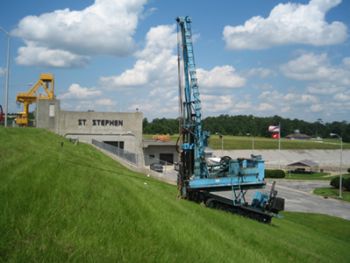ODEX Casing Advancement System: Difference between revisions
Rmanwaring (talk | contribs) (Created page with "<!-- Delete any sections that are not necessary to your topic. Add pictures/sections as needed --> __NOTOC__ ---- {{Picture <!-- Add image file name (ex.image.jpg) --> |image= <!--Add link if applicable --> |link= <!-- Add picture caption --> |caption= }} <!-- Introductory paragraph or topic page summary --> "Overburden drilling eccentric casing system (ODEX) equipment is relatively new to the drilling industry. The system employs a pilot bit and an ecce...") |
Rmanwaring (talk | contribs) No edit summary |
||
| Line 4: | Line 4: | ||
{{Picture | {{Picture | ||
<!-- Add image file name (ex.image.jpg) --> | <!-- Add image file name (ex.image.jpg) --> | ||
|image= | |image= USACE_Savannah_District_-_Geotechnical_&_HTRW_Capabilities_(8476083663).jpg | ||
<!--Add link if applicable --> | <!--Add link if applicable --> | ||
|link= | |link= | ||
<!-- Add picture caption --> | <!-- Add picture caption --> | ||
|caption= | |caption= Drill Rig | ||
}} | }} | ||
Revision as of 16:06, 25 October 2022

|
| Drill Rig |
"Overburden drilling eccentric casing system (ODEX) equipment is relatively new to the drilling industry. The system employs a pilot bit and an eccentric, under-reaming bit that swings out due the rotation of the drill stem. It also requires the use of a down-the-hole hammer and a specialized drive shoe. The under-reamed hole is slightly larger than the diameter of the casing, so as the bit advances the casing follows directly behind, and there is never an open hole. Casing walls can be thinner as they do not have to withstand percussive action. The system has been used to reliably drill holes more than 300 feet deep."[1]
"Large voids, loosely consolidated sediments, and severely fractured rock can lead to circulation loss and hole cave-ins using conventional drilling methods. ODEX systems can be used in more difficult geologic conditions such as glacial till; volcanic flows with hard flow material interlayered with gravels and flow breccia; and near-source colluvium and high-energy fluvial environments where cobbles and boulders are present within a loose matrix.[1]
"ODEX can be used with any pneumatic or hydraulic top hammer that has independent, reversible rotation, with sufficient torque to match the hole diameter and depth requirements. When drilling through overburden to bedrock, drilling is stopped briefly when the casing enters the bedrock. Reverse rotation is applied, which causes the reamer to turn in, thus reducing the overall diameter of the drill bit assembly. The drill string can then be pulled up through the inside of the casing and drilling into the bedrock can then be continued with conventional drilling equipment."[1]
"The ODEX drilling sequence is described as follows:
- When drilling starts, the ODEX reamer swings out and reams the pilot-hole wide enough for the casing tube to slide down behind the drill bit assembly.
- When the required depth is reached, rotation is reversed carefully, whereupon the reamer swings in, allowing the drill bit assembly to be pulled up through the casing.
- Casing tubes that are to be left in the drill hole should be sealed at the bottom of the hole by means of cement grout or some other sealing agent.
- Drilling continues to the desired depth in the bedrock using a conventional drill string."[1]
Best Practices Resources
![]() National Engineering Handbook: Chapter 5 - Engineering Geology Logging, Sampling, and Testing
National Engineering Handbook: Chapter 5 - Engineering Geology Logging, Sampling, and Testing
Citations:
Revision ID: 4047
Revision Date: 10/25/2022
